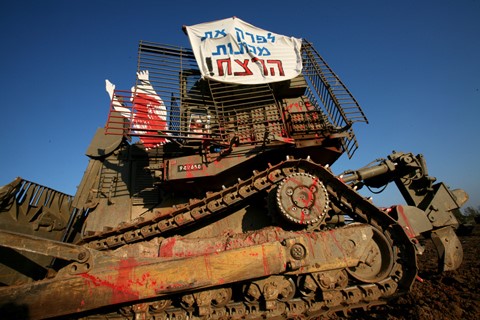Who Profits Research Center published a new report: “Facts on the Ground: Heavy Engineering Machinery and the Israeli Occupation,” which describes in depth how construction machinery became a vital component of the occupation mechanism
Since the early days of the 1967 occupation, Israel has used heavy construction machinery in order to strengthen its hold over the Palestinian territories (OPT) and Palestinian people by “establishing facts on the ground.” Excavators and loaders were – and still are – utilized to reshape the landscape: building infrastructure for the illegal Israeli settlement project; separating Palestinian communities from each other by creating roadblocks, barriers and apartheid roads; and demolishing thousands of Palestinian houses, public buildings and commercial properties, both as a punitive measure and in order to restrict the development of towns and villages. The many human rights violations perpetrated by Israel through the use of construction machinery in the OPT can be divided into four main categories: house demolitions, military use and control of population, settlement construction and the construction of the Separation Wall and the checkpoints. The following report provides a comprehensive description of these different categories of involvement in the occupation.

Peace demonstrators arrived on November 2006 to a military camp, between the Carni and Erez crossings, near Gaza Strip, serving as a parking lot for some 100 armored personal carriers (APC), tanks and Caterpillar’s D9 armored bulldozers. While some activists climbed on the D9 bulldozers to occupy them, others displayed dummies soaked in blood and photos of Palestinian victims on and around the armored vehicles (Photo: Al Ittihad)
As there is no significant local industry specializing in the manufacturing of construction equipment and capable of supplying the local demand, the Israeli heavy machinery market is based on import. Thus, most of the construction machinery sold in Israel is manufactured in Western Europe (primarily in the United Kingdom, Sweden and Germany), the United States, Japan, South Korea and Turkey. The major multinational corporations in the Israeli market are: Bobcat, Caterpillar, CNH Industrial, Doosan, Hidromek, Hitachi, Hyundai Heavy Industries, JCB, Liebherr,Terex and Volvo, all of which distribute their heavy construction tools through local Israeli representatives. The local distributors sell some of the imported machinery to the Israeli army and Israeli authorities; however, the greater portion of their revenues is generated from sales to public and private Israeli construction companies.
As detailed in this report, the scope and diversity of the use of heavy construction machinery within the framework of the Israeli occupation are overwhelming. Two troubling aspects of the distribution of civil and military engineering tools in the Israeli market must be addressed: the growing importance of engineering tools to the Israeli army’s military tactics and the large-scale complicity of the Israeli construction sector in demolitions and construction operations in the occupied Palestinian territories.
The central role played by heavy engineering machinery in the last two decades – in the attacks on Gaza and in urban warfare in the West Bank – stems from a rationale that puts the protection of Israeli soldiers and settlers above all, while the value of the rights and lives of Palestinian civilians is steadily declining. Unmanned, armored and armed D9 bulldozers razing Palestinian neighborhoods to the ground and extra-judicial killings executed by demolishing a house over a suspect’s head – are clear manifestations of this “minimum risk” doctrine. The sheer size and power of construction tools grant maximum protection to their operators and enable movement with little regard to the terrain. This is why the Israeli army considers them to be a strategic weapon. Thus, providing such tools to the Israeli army and the joint development of unmanned versions of heavy engineering machinery could be described as falling into the category of arms trade.
Examining the use of civilian engineering machinery in the systematic expansion of the settlements and their infrastructure, the construction of the Separation Wall and the checkpoints and the demolition of Palestinian houses – highlights the deep involvement of the Israeli construction sector in the daily maintenance of the occupation and in perpetuating the process of the colonization of the territories. The Israeli government may plan and fund the settlement enterprise and the varied control systems used to oppress the Palestinian people, but often the executing bodies, those implementing the policies and de facto changing the landscape, are private Israeli construction companies. As noted above, in the absence of a local heavy machinery industry, the construction sector in Israel uses imported equipment for operations inherently linked to human rights violations and repeated breaches of international law. The complicity of the Israeli construction sector in the occupation is a given, a characteristic of the local market. Considering the ethical problems that are deeply ingrained in operations in the Israeli market under the current circumstances, international manufacturers of heavy engineering machinery must address the devastating acts and human right violations executed using their products in the occupied Palestinian territories.
The full report (80 pages, English):


